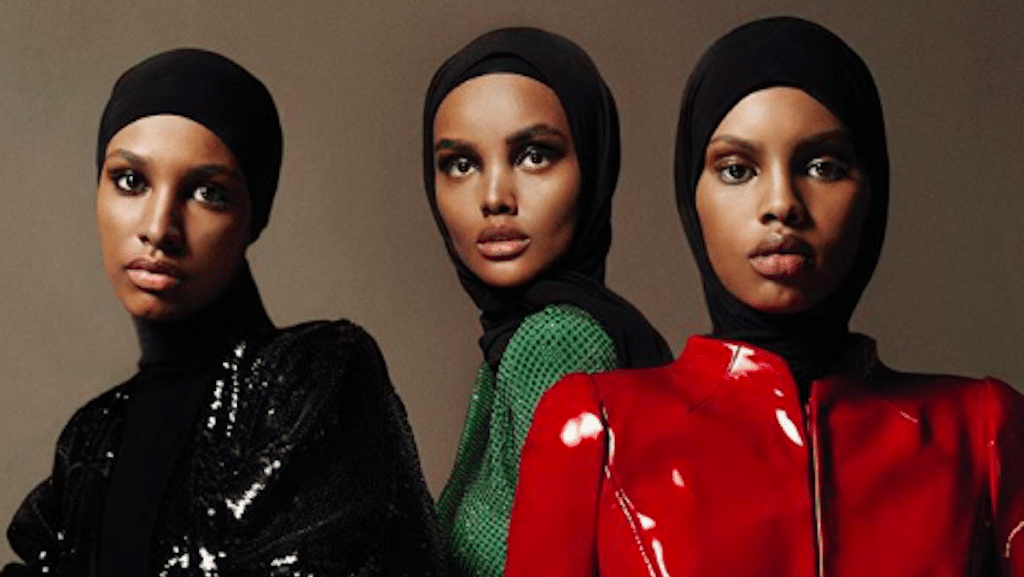Vogue Arabia decided to make history this month by featuring three Black hijabis on their cover. What does it mean to see people who look like you on TV, on social media, on magazine covers? What would it feel like to see them accepted, normalised, celebrated even; not demonised — for once? For a lot of Muslims, this isn’t even a remotely familiar experience. One can only imagine how much worse it is for those who have grown up Black and hijabi.
The April issue of the Vogue magazine features models Halima Aden, Ikram Abdi Omar, and Amina Adan and focusses on “shattering stereotypes”. While this isn’t the first time a model donning a hijab has been featured on the cover of the magazine, this particular cover is being applauded for acing the messaging as well as for having a group of women on its cover. “To think that just three years ago there was not a single Hijabi model and now fast-forward to the first Vogue Hijabi group cover,” wrote Halima Aden who has graced the magazine’s cover for the second time.
Two years ago, American supermodel Gigi Hadid faced tremendous backlash for wearing a hijab in her photoshoot featuring on the cover of Vogue Arabia. Hadid extolled her “half-Palestinian” roots while promoting that cover, but readers didn’t buy it. Appropriating an attire that often not only invites violent Islamophobia, but is also deemed ‘oppressive’ when worn by practicing Muslims — and then celebrated as ‘art’ when used as a costume — is extremely hypocritical and hollow.
Also read: My dress trolled because I’m a woman, says Shehla Rashid after Twitter slams hijab look
It is symptomatic of the mentality that refuses to see hijabi Muslims as anything but that. So, it doesn’t matter if you are elected to the US Congress, it doesn’t matter if you become a bronze-winning Olympic fencer, and it most definitely doesn’t matter if you get killed for your identity. The problem will still be you: your clothing, your lack of agency, your conditioning. The manner in which the hijab and hijabis are often made into spectacles makes one thing abundantly clear — everyone loves a young (hijabi) woman who can be rescued, everyone loves a project.
Interestingly, social media deep dives into a collective discussion on hijab almost once every month, because what better intellectual stimulant than analysing clothing you don’t know anything about, instead of the ones you wear everyday that will somehow never be a result of ‘conditioning’, always choice.
Something tells me it’s that time of the month again.
Choice and the lack thereof
Less than half a month ago, New Zealand witnessed deadly terrorist attacks on a mosque in Christchurch during the Friday prayers, killing at least 50. In what was a remarkable act of courage, solidarity and most importantly, leadership– the country’s Prime Minister Jacinda Ardern decided to don a hijab and say, “We are one. They are us.”
This was followed by many in New Zealand, including TV anchors donning the hijab to make a point. A point that many seemed to have missed.
“How could she do this when women in Iran and Saudi Arabia are forced to cover up?” some wondered in angst. Precisely because the values that New Zealand stands for would not allow for women to be singled out either for wearing something or for not wearing something.
The hijab isn’t purely co-incidental to Islamophobic attacks — it is often what drives them. To casually ignore that driver, even when a white supremacist leaves no space for doubt by meticulously writing a manifesto before the attack, is nothing short of naïveté.
Interestingly, though, this conversation on ‘conditioning’ takes the centre-stage only and only when the subject being discussed is a hijabi woman. Never so much when magazine cover after magazine cover objectifies women in clothing and via poses meant to reduce them to less-human and more-object.
Also read: Hijab not simply about religion, Muslim women wear it for several reasons
The best kind of questioning, the truly rebellious kind, however, wouldn’t even be that. It would be the kind that requires us to look inwards: Why am I wearing a saree? A saree meant for the very purpose of covering me in all of six yards. The kind of questioning that will not cause us to quickly defend certain manifestations of a religion as nothing but ‘culture’, but will make us realise that often culture is a derivative of religion.
Why am I wearing make-up everyday without fail — something that entails me transforming something as basic as my face? What is this patriarchy that won’t let me step out with my face without plastering it with cosmetics?
But such questioning would require us to let go of our patronising behaviour and paternalism, it would require a kind of self-reflexivity that goes beyond looking at anything ‘other’ with scorn.
“Patriarchy is back in ‘Vogue’,” a tweet read in reference to the Vogue Arabia cover.
Hate to break it to you, but patriarchy never stopped being in vogue. Introspective ability and self-awareness did, perhaps.
